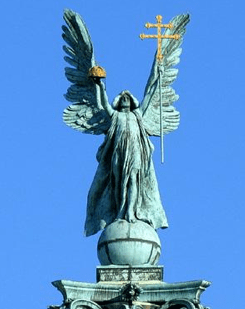Facts about Gabriel
Gabriel Biography
The angel Gabriel is a messenger from God in three major religions: announcer of the savior in Christianity, transmitter of scriptures in Islam, and an interpreter of visions in Judaism. His words to Mary (Luke 1:26-38) are read aloud in many Christian churches on Christmas Eve: “You will conceive in your womb and bear a son, and you will name him Jesus… The child to be born will be holy; he will be called Son of God.” In Islam, Gabriel (or Jibrail) plays an entirely different but equally momentous role: through him, God reveals to Muhammad the words later written down as the Qur’an (Sura 2:97-98). Islam teaches that the prophet then consulted yearly with Gabriel to make sure the words were exactly right. In the Hebrew Bible, Gabriel appears to the title character of the book of Daniel, who has had strange visions featuring a ram and a goat (chapters 8 and 9). Gabriel interprets these as part of a prophecy foretelling persecution but ultimately deliverance of the Jewish people.
Extra credit
Gabriel is also the angel who announces the coming birth of John the Baptist (Luke 1:5-24)… He is sometimes called an archangel, or high-ranking angel, along with other named biblical angels such as Michael and Raphael… Gabriel does not play a musical instrument in the Bible but often appears with a horn in popular songs, stories and art because of legends identifying him as the unnamed angel who announces Judgment Day by sounding the last of a series of trumpets (Revelation, chapters 8-11)… In mathematics, Gabriel’s horn (or trumpet) is the name of a figure with infinite surface area but finite volume, resulting from an equation developed by 17th-century physicist Evangelista Torricelli.

